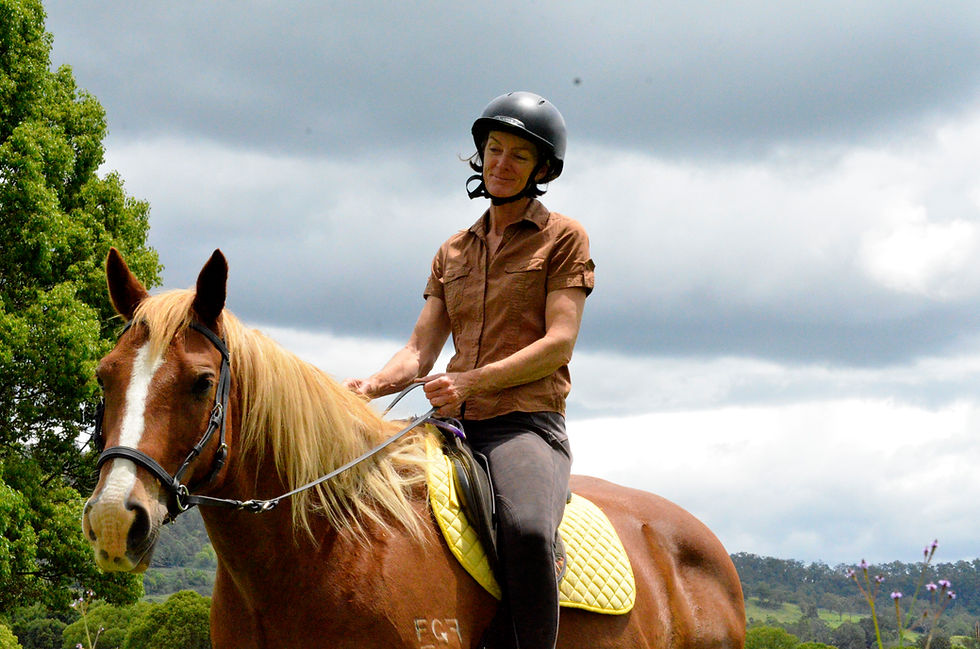Making the Change to Riding Bitless
- Suzy Maloney B.Eq.Sc.
- Apr 1, 2018
- 3 min read
Updated: Oct 19, 2024

I was recently talking with a lady who understood that animals are sentient and should be treated with respect and kindness. But even though she was clear about how animals should be treated she had trouble getting her head around the idea of riding with a bitless bridle. This got me to thinking about the ‘culture of horse riding’. In this culture it is a known fact that you cannot control a horse without a bit. It is ok to use force and pain to make a horse do want you want. The horse must do as you say, in fact if you don’t ‘make’ the horse do it you are ‘letting the horse win’ (the horses have no idea it’s a competition!). I must admit this is the world I came from. I aspired to do it all ‘properly’ and prove my worth by winning ribbons. The fact that it meant hurting my horse sometimes (it’s called ‘correcting’) was normal. I undertook years of riding lessons to gain my coaching certificate and used harsher and harsher bits. I rode with spurs and a whip. It was normal, everyone did it. And then something happened. A client of mine was getting a bitless bridle and I decided to get one too. We were going to Equitana and it was there we chose our bitless bridles. I went home to try it on my horses. I had 3 main riding horses at home and another 2 at work. I tried the bitless bridle on them all and they all went really well in it. It felt great because I wasn’t hurting my horses anymore. However I still kept doing all the same ‘domination over’ tactics. I rode the same as I had been taught, and was impressed with the results I was getting from the bitless. My horses were softer and more responsive and stayed calmer in elevated situations. But then the magic of the bitless bridle started having an effect on me. The connection between myself and my horses started opening up and changing. There was no longer pain for them while being ridden so they slowly emerged from this place where they’d been hiding. It was only then that I really realised what a huge thing a bit is, for the horse. For us it disappears when we pop it in the mouth and the mouth closes. We can’t see it so we don’t think about it. But the horse does. The whole time the horse is thinking about the pain in its mouth. Without that pain the horse starts thinking more about you and what’s happening. They start responding to more subtle cues, which they can now perceive without the loud noise of the bit. The rider can get lighter and lighter with the cues and the horse will hear them. The rider ends up doing less while the horse does more. This lady thought her riding skills weren’t good enough to ride bitless. But if our riding skills aren’t high we should definitely be riding bitless. To put a bit in the hands of an inexperienced rider should never happen for animal welfare reasons. With a bitless bridle we have full control, but if something happens and the rider jerks on the reins there is no pain for the horse. This means the horse stays calm which is much safer for the rider. After we’d talked for a while the woman asked if she could try the bitless bridle. I will assist her with transitioning and with improving her confidence, but I know that once she ‘gets it’ she will never look back. It’s one of those ‘you don’t know what you don’t know until you know it’ situations. Once you know you will never use pain and domination tactics with a horse again. Making the change to riding bitless opens up a whole new world of connection and communication.
Suzy Maloney B.Eq.Sc.
Happy Horses Bitless
Lismore, NSW, Australia
Ph: 0401 249 263
Email: happyhorsesbitless@gmail.com
Web: www.happyhorsesbitless.com
Facebook: Happy Horses Bitless Bridles



Comentarios